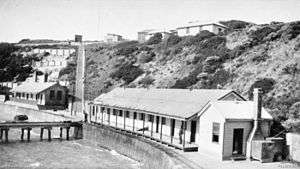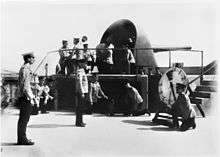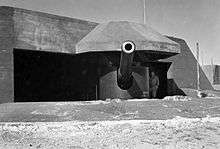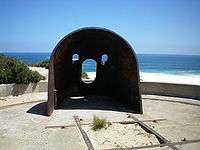Fort Nepean
Coordinates: 38°18′11″S 144°39′09″E / 38.303°S 144.6524°E


Fort Nepean is a former defensive facility occupying part of Point Nepean, Victoria, Australia. It was part of a network of fortifications, commanded from Fort Queenscliff, protecting the narrow entrance to Port Phillip.
Background
Following the 1875–76 Royal Commission into the Volunteer Forces, the Victorian Government invited the Director of Works and Fortifications in London, Lieutenant General Sir William Jervois, to Victoria to further advise on Victoria's defences. He arrived in 1873 accompanied by the Colonel Scratchley. Their joint report recommended that the basic defences for the Colony should be concentrated on the Heads, and consist of fortifications at the entrance to the Bay and on the shoals between the main shipping channels.
Fortifications and guns

Fortifications and barracks were built on Point Nepean from 1873 and gun batteries were installed in 1886. By the 1890s Fort Nepean was known as "Victoria's Gibraltar".[1] The barracks housed a Company of the Royal Victoria Volunteer Artillery Regiment.
1878–1880
The first coastal defence guns on the site were four 80 pounder Rifled Muzzle Loading guns in two temporary sandbagged batteries. These were moved into more substantial earth emplacements from 1880.
1886–1890

Ten gun emplacements were constructed between 1886 and 1890 but not all had guns installed. By 1890 there were four 6 inch breech-loading (BL) disappearing guns, two BL 9.2 inch (234 mm) Mk VI breech-loading 'counter bombardment' British Armstrong guns, a 4.7 inch quick firing (QF) gun and a QF 14 pounder. One of the former 80 pounder emplacements was used as an observation post and one new emplacement was used as an armourer's store.
Two of the same type of BL 9.2 inch (234 mm) Mk VI gun were installed at Fort Queenscliff. One each of the guns was installed at Ben Buckler Gun Battery, Signal Hill Battery, and Steel Point Battery in Sydney. The barrel of the Signal Hill gun is on display at the Royal Australian Artillery Museum at North Fort, North Head, in Sydney. The Ben Buckler gun has been recovered and is awaiting restoration.
1907–1915
From 1911 the fort was manned by the newly renamed Royal Australian Garrison Artillery and the Royal Australian Engineers. With war in Europe looming, longer range 6 inch Mk VII guns replaced the 9.2 inch guns. One of the 6 inch BL guns was removed and the 14 pounder was moved to Fort Queenscliff. The 4.7 inch QF gun was removed and the emplacement fitted with a searchlight, along with an engine house to generate electricity. The remaining gun emplacements were renumbered – the Mk VII guns were numbered A1 and B1, and the 6 inch BL guns numbered F1 and H1.
1939–1942

Light anti-aircraft guns were deployed at the fort in 1939. The remaining 6 inch BL guns were removed in 1940. The A1 and B1 emplacements were renumbered F1 and H1 respectively, and fitted with concrete hoods.
World Wars

The first Australian shots (many sources report the first Allied shots) of both World War I and World War II were fired from Fort Nepean.[2][3][4][5][6][Note 1]
On 5 August 1914, the German ship SS Pfalz attempted to escape from Port Phillip. Within minutes of being notified that war had been declared, Lieutenant-Colonel Sandford at Fort Queenscliff gave an order to Lieutenant C Morris, the Fire Commander at Fort Nepean, to "stop her or sink her".[7] After the Pfalz ignored signals to halt, the B1 gun fired across her bow. The Pfalz then turned around and the crew was arrested at Portsea.
At 1.30am on 4 September 1939, within hours of war being declared, the A1 gun fired across the bow of a ship which failed to identify itself. The ship then identified as the Australian freighter SS Woniora.
These were the only occasions any of the Port Phillip batteries fired in anger.[6]
After World War II
With the removal of coastal artillery after World War II, the guns were dismantled and sold for scrap. The barrels of the historic Mk VII guns which fired in anger were retrieved from the Port Wakefield artillery proving ground and a scrap yard at Brooklyn, Victoria in the 1960s and returned to the fort.[4]
National Park


The area was opened to the public in 1988 upon the formation of the Point Nepean National Park.
See also
Footnotes
- ↑ While many sources report that the fort fired the first Allied shots of both world wars some sources state that they were fired by Fort Perch Rock on the Mersey River in the United Kingdom. See Bird, Robin (20 August 2014). "How fort fired the first shot of the Great War". Wirral News. Liverpool.
Citations
- ↑ "Point Nepean Defence Sites and Quarantine Station". Department of the Environment, Water, Heritage and the Arts. Retrieved 2008-10-28.
- ↑ "People power wins out at Point Nepean". The Age. 2003-08-26.
- ↑ "Point Nepean becomes site of land battle". ABC: 7.30 Report. 2003-12-03.
- 1 2 "Historic barrels fire up memories of battles past". The Age. 2004-08-04.
- ↑ "Portsea Heritage Note" (PDF). Parkes Victoria. 1996.
- 1 2 Point Nepean Forts Conservation Management Plan, p11
- ↑ J. Tate (1982). A history of Fort Queenscliff in the context of Fort Phillip defences. Fort Queenscliff Museum. p. 64.
References
- Armament Establishment, Detail of Equipment for Forts at Port Phillip Heads, Garrison Service, NAA:B77856, 12094 1882/644A, National Archives of Australia.
- Drawings and plans of fortress installations — Port Phillip Defences, MP338/2, National Archives of Australia.
- Point Nepean National Park Fortifications, Conservation Plan, Department of Conservation, Forests and Lands, January 1990.
- Point Nepean Forts Conservation Management Plan, Parkes Victoria, July 2006.
External links
 Media related to Fort Nepean at Wikimedia Commons
Media related to Fort Nepean at Wikimedia Commons